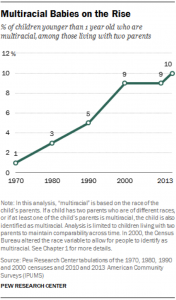by Rachele Byrd, Shivani Dayal, and Molly Hoyer
Between 1990 and 2000, the percentage of babies in the US born to two parents of different races rose significantly, from 5 to 9 percent. This increase is part of a larger trend in the United States that, over the course of the last thirty years, has seen the population of multiracial infants grow by 9 percent total, as reported by the Pew Research Center. Now, in 2017, these multiracial infants have become or are becoming adults capable of contributing to and changing the dialogue on race and ethnicity. The timing of the population surge is
 especially important: not only are those infants born during the 1990-2000 time period now in their late teens and early twenties—a time of life known for engagement with social justice issues and activism—they are also the first generation to have grown up with the Internet, which puts them in a unique position to widely share their perspectives and experiences with the world and thereby effect change.
especially important: not only are those infants born during the 1990-2000 time period now in their late teens and early twenties—a time of life known for engagement with social justice issues and activism—they are also the first generation to have grown up with the Internet, which puts them in a unique position to widely share their perspectives and experiences with the world and thereby effect change.
All of this has led many experts and authors to consider what the country’s racial makeup may mean for America’s future. Moises Velasquez-Manoff, a health, science, and environment contributing op-ed writer for the New York Times, recently wrote about the subject in an article titled, “What Biracial People Know.” He argues that multiracial people have a kind of mental flexibility that allows them to shift between social groups and think more deeply about the world. He cites example after example of the advantages of being multiracial that culminate in his statement that “diversity — of one’s own makeup, one’s experience, of groups of people solving problems, of cities and nations — is linked to economic prosperity, greater scientific prowess and a fairer judicial process.” However, in a 2011 survey, researchers found that “as whites reported decreases in perceived anti-black bias, they also reported increasing anti-white bias, which they described as a bigger problem.” In other words, “whites saw race relations as a zero-sum game. Minorities’ gain was their loss.” Moises argues that the growing multiracial population might work almost like a vaccine and grant the country immunity against racist tendencies, since their fluid identity challenges people’s conceptions of race and perhaps gives people more exposure to other races.
Alexandros Orphanides, a political writer for NPR, challenges Velasquez-Manoff’s argument and says that viewing the future multiracial population as the vaccine to racism is misleading because it “presents racism as passive—a vestigial reflex that will fade with the presence of interracial offspring, rather than as an active system that can change with time.” Not only does this idea of a vaccine to racism paint an inaccurate view of the nature of racism, but it also inaccurately assumes that multiracial people actually do have a fluidity between racial groups when in fact many are constantly told they do not belong to one group and can only have one identity. Instead of debasing racism, multiracial people are categorized into the system and then treated as such—many describe a “binary black/white or White/non-white form of discrimination” when it comes to a “wide range of contexts, including education, employment, public accommodations, and criminal justice.” And even in communities that are labeled as almost totally racially mixed, like Venezuela or Brazil, colorism (which it could be argued is a subset of racism), is still alive and well. People’s tendency to prefer some races over others does not automatically go away with an increase in racial mixing, although it may mitigate it to some degree.
Having examined the arguments and rhetoric of both of these articles, it appears that Moises’s article places a large amount of pressure on non-white people to educate and widen their friends’ perspectives. This may work in the short-term to reduce prejudice, but in the long-term it is not enough because, according to Orphanides, it is still working within a system where Whites have historically been in power. For real change, we need to deconstruct white supremacy entirely, otherwise racism will just continue to morph and change based on the people who inhabit the system. For example, many European immigrants were discriminated against before they were assimilated into the “white” category. In another example, “mulattos” were labeled neither white nor black but as a race of their own. They were discriminated against accordingly. It is understandable that interacting with multiracial people may help change society’s overall opinions about the preference it gives to some races, but it is not realistic to say that people of mixed race are the cure for racism. History has proven that people adapt their forms of racism based on the situations of their time and place.
Image credit: Chris Price, “Interracial art,” http://bit.ly/2p6nKUF, via Flickr.

